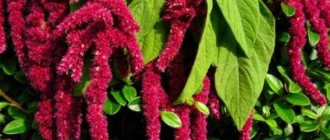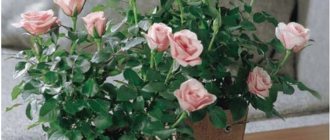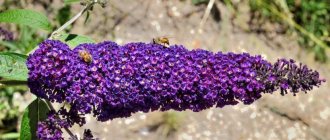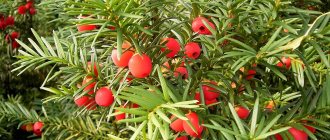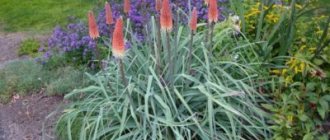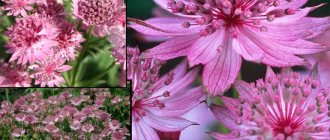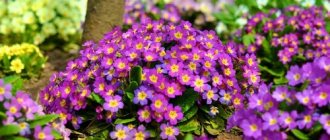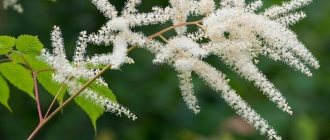Plant varieties
The plant is disliked for its uncontrollable growth. During the summer season, it can spread its shoots several meters beyond the bush, which causes a lot of difficulties for the gardener to care for it. Because of this, you need to remember that the plant needs a large area to grow . You should consider the most popular types of the knotweed plant.
Highlander changeable
The knotweed flower belongs to a herbaceous plant used for planting in open ground. Its homeland is East Asia. It grows as a large bush up to two meters high and is used in gardening as a perennial.
The inflorescences are large, with numerous small flowers on white or pink panicles. The smell is bright, similar to the aroma of honey. Flowering period: July-August.
Despite the significant volume of flowering clusters, they do not need to be tied up. Large stems thicken towards the base and begin to branch at the top, where the inflorescences are located. Inside, the stems are empty with massive pulp. At the end of flowering they turn purple.
The roots are very powerful, going no more than half a meter deep. They can support a large shrub and grow in the soil virtually under the entire surface of the flower, not just near the stem.
The foliage, unlike many other plant varieties, covers the entire length of the stem. The leaves are oblong, which gives the bush volume. Large bushes of the knotweed with a snow-white cloud stand out among other flower crops on the site.
Viviparous species
This is a miniature variety, the plant height does not exceed half a meter. Homeland is:
- Europe;
- Asia;
- North America.
Under natural conditions, the plant grows in wet meadows and forests.
The stems are straight, hard, knotty, and have lanceolate-shaped leaves ten centimeters long. On numerous stems at the ends there are dense brush-shaped inflorescences no more than fifteen centimeters long. The inflorescences consist of tiny flowers of a raspberry-pink hue. The flowers are bright and eye-catching.
The flowering period is quite long, from June to September, while the inflorescences do not lose their shape and beauty. It is not often that you find such a long-flowering plant in your garden.
The flower loves fertile soil , well fertilized. It is better to plant it in partial shade, where the inflorescences appear more brightly. You need to plant it in the first row near a pond or an alpine hill, the plant will look very beautiful and elegant.
You can propagate the bush by dividing the roots , which take root well by cuttings taken with a bud from the lateral shoots, or by a small onion that appears instead of flowers in an inflorescence. The plant is resistant to cold, but may suffer in a snowless winter, so it must be covered during the winter, primarily protecting the root system.
Related flower
Knotweed is a herbaceous perennial no more than twenty-five centimeters high, with evergreen long green leaves that form a dense carpet.
The inflorescences of this species are identical to those of the knotweed viviparous, also in the form of a spikelet with small pink flowers. The inflorescences are strong, no more than ten centimeters long. The flowering period is long: from June to September.
The plant looks great even after flowering, as the foliage and flowers turn a dark scarlet hue. A carpet of foliage and beautiful inflorescences go well with astilbes, low hostas and bulbous flowers.
The species is not picky about the composition of the soil, but it requires a drained area. It is resistant to drought and does not like stagnant moisture in the soil. The variety tolerates frost well, but during snowless winters it requires shelter.
Sakhalin knotweed (video)
Aubert's Highlander
Polygonum aubertii is native to Western China. This is a shrubby vine, low and climbing. The trunk becomes slightly woody, the shoots even less.
The leaves are ovate, with wavy edges, initially reddish, later bright green.
Numerous racemes formed in the upper part of the shoots consist of greenish-pale, sometimes pink, small flowers. Forms a fluffy blooming continuous wall. The fruits are inconspicuous, whitish, small.
The plant is propagated by seeds. It grows well in fertile, moderately moist soils and can grow in partial shade. In winter, during frosts, the above-ground part dies off, then quickly grows back.
In ornamental gardening, it is highly valued for its dense, bright green foliage; it is planted to create low hedges, and the lower part of walls is planted with knotweed.
Reproduction methods
This variety cannot be grown from seed. Knotweed can be propagated using cuttings or root shoots. The use of any dilution method depends on the time of year. For example, in spring, before inflorescences form, flowers are most often propagated by shoots. Due to the fact that the roots of young shoots have not yet gained strength, this breeding method is the most effective.
This variety of highlander is so unpretentious that it can be propagated using cuttings. This method can only be used in summer during the flowering period. However, the cuttings must be prepared in a certain way and only then are they allowed to be replanted as an independent plant.
Beneficial features
Dried roots of knotweed are used as raw materials for the preparation of medicines that have an anti-inflammatory and hemostatic effect on the human body.
A tincture of powder prepared from the roots of the plant is used as a folk remedy for inflammation, diseases of the gastrointestinal tract, stones formed in the kidneys, and sore throat. For diarrhea, this powder is taken orally in dry form.
Landing rules
Planting and care will not cause big problems for the gardener. To grow a beautiful and healthy plant that pleases the eye, you need to follow some simple rules:
- For initial planting, choose a sunny location. A slightly shaded space in the flower bed is best suited for the development of knotweed.
- No special soil is needed for planting. The main thing is that the soil is fertile and moist with little acidity. To fertilize the soil, it is allowed to use compost with the addition of ash to increase the alkaline environment of the soil.
- The plant can be propagated in spring or summer. The easiest propagation option is the use of root shoots.
- The shoot of the knotweed is a full-fledged plant with an independent root system. It takes root quickly.
- The new flower must be separated from the adult plant and immediately planted in the prepared soil. In order for the shoot to quickly take root, you need to shade it a little.
- Plant the plant shallowly so that the roots do not begin to rot and can receive oxygen. At this stage it is necessary to constantly water the flower.
- To propagate a plant from cuttings, you need to choose young and strong shoots. This needs to be done in the spring.
- To plant, you need to bend the stem to the soil and hill it, then water the soil. It is necessary to control that the cuttings do not get wet, otherwise the roots will rot. As soon as the sprouts appear, it is necessary to clamp the stem with an iron ring, this will reduce the nutrition from the adult bush.
- Thirty days before the planned transplant, it is necessary to completely separate the shoot from the adult plant, but not dig it up. After the shoot produces roots, it is planted in a permanent place.
The variable mountaineer takes root well in a new place and adapts in a very short time. The roots develop dynamically; as a result, after growth, the shrub must be limited in subsequent reproduction, shoots must be dug up or replanted.
The perennial is capable of growing. If you do not remove young shoots from the root system, it may take on a shapeless appearance. In addition, the shoots will take nutrition from the adult plant, which will weaken it.
If the flower has dried out after replanting, there is no need to dig it up. It is necessary to continue watering, and after a few days new shoots will appear. The perennial can not be replanted for ten years.
Uses of knotweed
A little about the use of knotweed herb. Previously, dyes were made from this plant: various warm colors were produced from the above-ground part, and blue paint was produced from the underground part.
Ant is excellent for livestock feed; birds especially love it, which is reflected in some variations of the name.
In the cuisines of many nations, young shoots are added to various hot dishes, salads and baked goods.Greens are added to soups at the end of cooking so that the knotweed herb retains its beneficial properties.
Required care
The plant is unpretentious in care. Any amateur gardener can handle it. The main thing is to follow the recommendations:
- Watering is required moderate depending on the climate. On hot days, abundant watering is necessary, since the roots are located on top and cannot receive water from the ground. If you do not provide good watering, the plant may be attacked by aphids. With regular watering, the knotweed will suffer little pain, as it will be able to resist diseases on its own.
- To simplify maintenance, you need to mulch the soil. An auxiliary crust of peat will help retain water and prevent the bush from getting wet during the rainy season, protecting the roots.
- The plant is pruned in the spring before buds appear. If this is required, then also in the spring, shoots are dug up to form a crown.
- Highlander tolerates cold well, so there is no need to cover it additionally. In a harsh winter, certain stems will freeze, but the plant will quickly recover and send out new shoots in the spring.
- In autumn, all stems are cut off. The height of an individual branch should not be less than thirty centimeters from the ground surface. However, in the first two years after planting, young shoots must be covered for the winter, as weak stems will die.
- During the flowering period, you need to fertilize the plant. Manure applied during irrigation is perfect for this. Feed the flower only once per season.
- During the flowering period, watering is reduced.
- Weeds do not grow near the flower, so there is no need to weed the plant.
Contraindications and precautions
Despite recommendations for using knotweed herb to increase the likelihood of conception, you should not drink it during pregnancy, as it increases the tone of the uterus, which creates a risk of miscarriage.
- Lyubka bifolia - medicinal properties and the best recipes from traditional medicine (110 photos)
- Jaundice - description of the plant, medicinal properties and features of use in folk medicine (80 photos)
Field thistle - medicinal properties, recipes, uses and contraindications of thistle (video + photo)
This medicine is not suitable for hypotensive patients either, because it lowers blood pressure. It can also be harmful in acute kidney diseases.
Herbal medicine, like any treatment, requires prior consultation with a doctor. A specialist will help you figure out whether you have contraindications to the use of knotweed herb.
Origin
Scientists classify the plant Highlander (Polygonum) as a member of the Buckwheat family. The flower is popularly called buckwheat and buckwheat, and translated from Latin the name means “having many knees,” which indicates the structure of the knotty stem of the knotweed.
Knotweed is widespread in the temperate zone of Eurasia and North America.
Homeland of the plant
The genus Highlander is represented by many species of plants, noticeably different from each other: low-growing herbaceous bushes, vines, subshrubs reaching a height of more than 200 cm, annual and perennial plants. In total, there are more than 250 plant species in the genus, of which two dozen have been cultivated.
Representatives of the genus are used not only as an attractive and unpretentious ornamental plant, but also as a medicinal plant (Knotweed).
Growing in the garden
For the plant, choose a sunny area with loose and fertile soil. In dense shade, the foliage of the knotweed loses its decorative effect. Fertile loams that retain moisture well are suitable for the plant. It is necessary to add humus to sandy soils to increase the fertility and moisture capacity of the soil.
Important ! The knotweed plant tends to grow and quickly spread throughout the area, suppressing neighboring plants. To prevent this from happening, the planting site for the knotweed is limited to buried sheets of tin or a special plastic border.
Plantings of knotweed require regular moistening; flowering knotweed especially needs moisture. Mulching the soil around the bushes with peat, wood shavings, and straw can reduce the need for water.
During the period of active growth and flowering (from April to September), it is useful to apply fertilizer to the plants, alternating nitrogen and mineral mixtures. It is enough to fertilize the knotweed once a month.
Knotweed responds positively to pruning. Lush bushes are sometimes thinned out to improve lighting within the crown. Ground cover species are formed into neat clumps, removing excess branches. In autumn, it is recommended to prune perennial species, leaving stems about 10 cm high.
knotweed
For the winter, the plant does not need shelter; only young plantings are covered with spruce branches and sawdust. If the aboveground part of the knotweed freezes, then new growth quickly grows from the roots.
Features of cultivation
This is a plant of cool, shady and humid places; most varieties winter well in the middle zone and the Moscow region.
In well-lit places, persicaria may lose the brightness of the foliage color.
It is important to remember about the aggressiveness of the plant. The mountaineer quickly grows in breadth, filling all available space and oppressing its more modest neighbors. To prevent it from crowding out other plants, the growth of the root system is limited by digging strips of tin or special flexible plastic around the bush. This obstacle will prevent the roots from spreading uncontrollably.
Description
A common unifying feature for all types of knotweed is the structure of the stem, which has numerous bends and nodes. The stems of knotweed can be erect, creeping or climbing. The stems are densely covered with simple-shaped leaves on elongated petioles.
The roots of most plant species are well developed and creeping. There are species with a tap root system.
Polygonum flowers are miniature (white, pink or red), growing at the top of the stem, collected in racemes, paniculate or spike-shaped inflorescences. The knotweed bushes are abundantly covered with flowers, from May until the coldest weather. The seeds of the plant are enclosed in fruits - small dark nuts.
- The related knotweed is a widespread garden flower. Forms dense curtains, no more than 30 cm high. The foliage is bright green, collected in rosettes, lanceolate in shape. Pink flowers are in spike-shaped inflorescences, 8 cm long; after blooming, they darken, becoming crimson. Varieties: Darling Red (deep pink-crimson flowers) and Donald Londes (pink-red inflorescences).
Related
| Polygonum virginianum, Persicaria virginiana family (Polygonaceae) |
- The amphibious knotweed is used to decorate the banks of natural and artificial reservoirs. The aquatic form of knotweed takes root at a depth of 10–14 cm; stems and narrow leaves float on the water surface. Light pink spikelets, consisting of small flowers, stick out 5 cm from the water, like small bright candles.
- Alpine mountainc grows up to a meter in height, forming a lush bush, with elongated (up to 12 cm) emerald foliage. Paniculate inflorescences of white or yellow hue.
Alpine - Bluebell knotweed grows up to 90 cm, forming dense and dense thickets. It is distinguished by abundant and attractive blooming of pink flowers that look like bells.
- Capitate knotweed is a dwarf plant, up to 12 cm high. The clumps reach 30 cm in diameter. Pink flowers are collected in inflorescences - balls.
Capitate - Candle-shaped . The plant, native to the foothills of the Himalayas, forms meter-long lush bushes. The foliage is elongated, bright green in summer, turning golden in autumn. Inflorescences in the form of a spike, rich scarlet color, appear in July and remain decorative until September. Varieties: Album (white flowers), Roseum (pink), High soseti (raspberry), Inverleith (miniature knotweed with red flowers).
- Twice twisted. An unpretentious and quickly growing plant, reaching a height of half a meter. Pointed narrow leaves are concentrated in basal rosettes, the stems are bare. Cream or pinkish flowers are collected in small spikelets. Double twisted knotweed is an excellent honey plant and medicinal plant.
Twice twisted - Variable knotweed is an Asian variety that is very popular among gardeners. The abundantly flowering bush grows up to 200 cm in height and up to 150 cm in diameter. The stems of the flower are erect, densely leafy, crowned with paniculate large white inflorescences. Variable knotweed blooms for more than 50 days in July–August, spreading a strong honey aroma.
- Bird's knotweed (knotweed) is a medicinal annual plant, widely distributed in fields and meadows of the temperate zone of the Northern Hemisphere.
It is considered a weedy unpretentious plant. Knotweed is valuable as a feed (its nutritional value is equal to that of legumes); a decoction of the herb is used to rinse hair to improve growth and is used as a fabric dye. In medicine, it is widely used for hypertension, tuberculosis, inflammation of the kidneys, stomach and intestines, and liver diseases.
You can get acquainted with the appearance of the plant from the presented photos of the knotweed.
Photo of knotweed grass
Read here! Snake knotweed - description, recipes, use, properties and contraindications for use (105 photos)
Please repost
0
